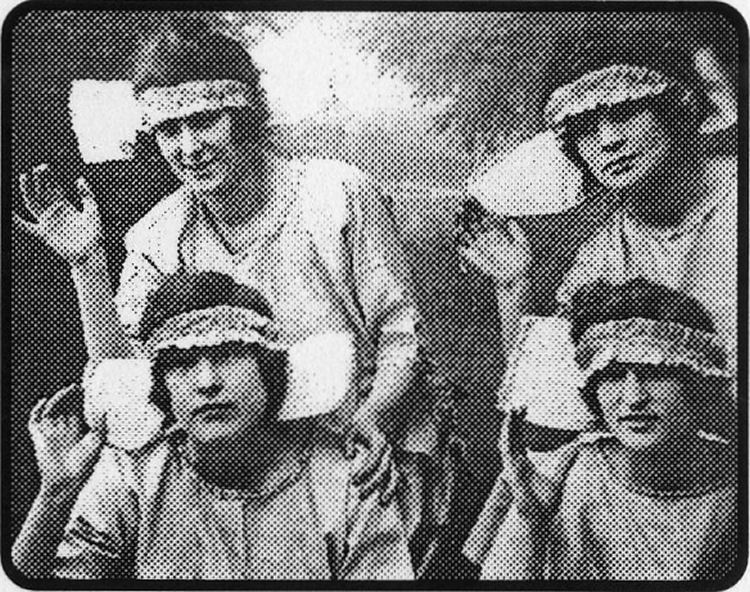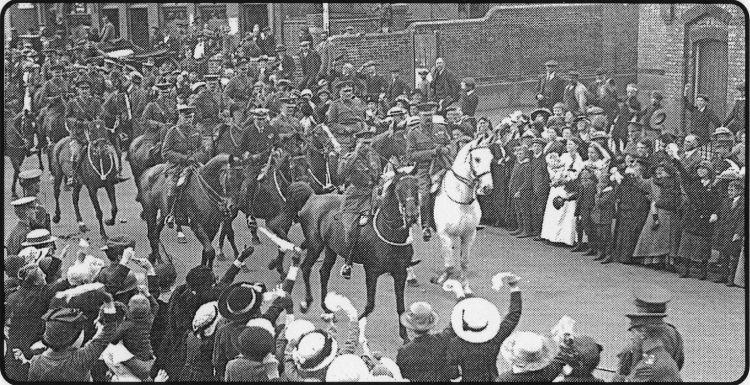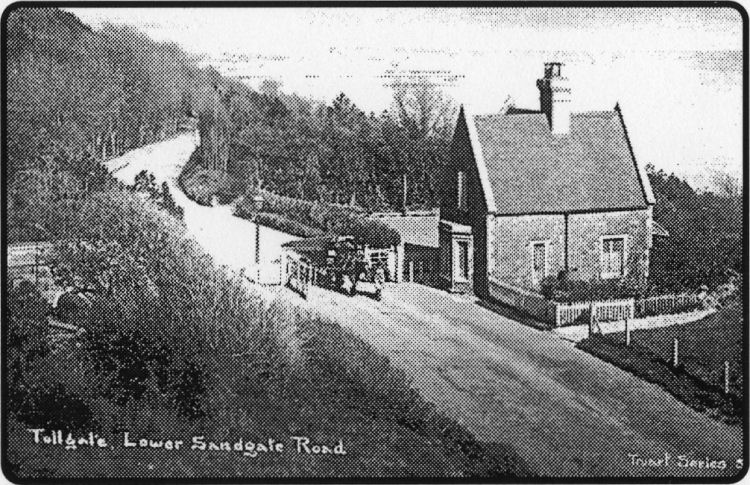
Published 17 August 2000
I had forgotten that in the old days of toll roads, a great number of
which I believe were abolished by Act of Parliament in the 1870s, there were
often several gates outside towns and villages.
And I thought the photo I had tracked down was so good it deserved an airing
when I heard that the old Lower Sandgate Road tollhouse was on the market.
Eamonn Rooney, who works on the Leas lifts, pointed out Croft House, on the
left of the picture still stands and it is on Sandgate Hill, practically
opposite where the bottom station of the former Sandgate Lift was sited.
This tollgate and house was part of the Dover and Barham turnpike road
system, says Eamonn. Speaking from memory, he said he believes it
was demolished about 1877.
Below is a picture of the Lower Sandgate Road toll-gate and house I was
writing about last week. It comes from Folkestone Herald files.
The picture, right, dates from August 1915 and depicts His Majesty King
George V riding with Field-Marshal Lord Kitchener, of Khartoum, the
Secretary of State for War, in Cheriton for a review of Canadian troops at
Shorn-cliffe Camp.
Birthday
The Earl joined the King on the royal train from Windsor en route to the old
Lyminge station where the party were met by Major-General Sam B. Steele CB,
Commander of the troops at Shorncliffe.
The royal party then proceeded to Beachborough Park, opposite the Canadian
military hospital, and the home of Sir Arthur and Lady Markham, at
Beachborougn House. And it was here that the troops paraded. Kilted
Highlanders were prominent.
Wrong road!
WHOOPS! I really slipped up with the tollgate photograph last week. Two
Memories readers, including local historian Eamonn Rooney, were quick to
point out I had selected a picture of the wrong tollgate!
The royal party on horseback went through Cheriton on the way back to join
the royal train waiting at Shorncliffe station.
I am prompted to publish the picture this week as a result of a letter from
Mrs CE. Martell of Pitstone, Leighton Buzzard, who says her mother; born in
1910, and who celebrates her 90th birthday at a family gathering this
weekend, saw the royal party riding through Cheriton.
“The photograph in one of the papers showed the King riding by and in the
background, on a wall was my mother and her siblings.
“On the strength of that photograph her father, who was out in Egypt,
increased their allowance because of the holes he must have spotted in my
mum’s stockings!” writes Mrs Martell, adding that her mother’s maiden name
was Frances Mason. She now lives in Ashford.
What a lovely story!
Mrs Martell is planning to surprise her mother by presenting her with
photocopies of the report of the event in the local papers, which I have
made for her.
On a sadder note, Mrs Martell says that she would also like a photocopy of
the report of a
tragedy that her mother also witnessed and was personally involved in.
Frances Mason was involved in a bus accident in Cheriton in which one of her
friends was hit by a reversing bus and killed as they sat on the pavement
outside the cinema.
The death of the nine-year-old girl, Frances Ellen Laycock took place only a
few weeks before the visit of the King.
At the inquest when an accidental death verdict was recorded the driver of
the bus was exonerated after evidence that one of the soldiers in a crush of
people on the bus jogged the steering wheel, causing the bus to veer towards
the children.
PERFORMING in a local laundry workers' concert in 1919 were Dorothy Scowen
and Margie Penfold, with Min Crawley and Marian Scowen in front. Derrick
Lawson, of Lynwood owns the family photo



 |
|
1900
Earl joins wounded troops returning from Boer War.
«4 nAAEARt Radnor, who had been involved XvUUin the Boer War conflict in
South Africa, was reported to be so much improved in health that he had
embarked on a ship for home. Lyminge parish church had been closed for
restoration since last April and efforts were being made to boost funds
with a variety of events including a garden fete in the rectory grounds.
Local newspapers were carrying lists of visitors currently staying at
the local hotels and a list of the latest people to have phones
installed, such was the novelty of a phone a century ago! The needs of
wheelchair users were taken into account when designing buildings a
century ago. And this was certainly the case with new Wesleyan Garrison
Church at Sandgate which was built close to the John B. Gough Soldiers'
Home. Built of Kentish rag-stone with Bath slone dressings and a slate
roof, its striking feature was said to be the main entrance and flight
of steps. There was a convenience and ramp for wheelchair users, which
meant bath-chairs as they were called could be wheeled In without the
user having to get out of a chair. The church had seating for 400 and
some fine Cathedral glass.
|
|
1925
Cheerful Sparrows’ giant fete packs in the crowds.
4 no p THE EVENT of the season, the Cheerful JJZJsmZ} Sparrows' Hospital
Fete was supported with tremendous enthusiasm in spite of several hours
of rain which heralded the start of the three-day event, patrons of
which included the King, Earl Radnor and the Mayor of Folkestone. All
manner of attractions included a ‘Garden of Eden* sale of produce, a
Kentish : farmyard complete with sheep, lambs, cows, calves, a fat sow
with piglets and a wide variety of poultry. There was a hum of a
threshing machine, music from steam and electric organs, a brie a brae
section with Hems ranging from clothes to a motorcycle and an old
wagonette. A grand tombola boasted £1,000 worth of prizes. One hundred
Hythe traders and other people were backing a petition urging the Town
Council to think again about its decision to route buses away from the
busy High Street. Traders countered the Council plan with a suggestion
buses from the Folkestone direction should enter the High Street but
leave via Rampart Road and Prospect Road. But the Council refused to
change their traffic plans. Anti-social motorcyclists were creating a
racket on the Leas, riding noisily up and down during band concerts and
at least one local resident wrote to the Herald urging that the road be
closed while the band was playing.
|
|
1950
Miss Folkestone made own dress-for just £1!
I QCAMISS Elizabeth Brlckell, 19, a shop ■L«7 OvF assistant who made her
own dress for a £1, was elected Miss Folkestone from 21 entrants.
Another success for women was the successful Channel swim of Miss
Florence Chadwick, from: France to England, in 13 hrs 23 mins. A
remarkable parade of holiday camp folk in historical costume, SO of
them, marked the 20th Anniversary of the founding of H.R. Madd-ieson's
holiday camp site at Greatstone- a parade in which holidaymakers were
encouraged to take part. Needleworkers worked wonders to re-create
colourful characters like Queen Elizabeth I, Sir Walter Raleigh, King
Charles and Nell Gwynne, Mary Tudor, Cardinal Wolsey, and typical
bathing belles of the 1890s and early 1900s. Most remarkable was that
all costumes were made of crepe paperl Herald man Roamer commented the
parade of historic characters made the dance hall a "perfect feast of
colour" at what he believed was the first holiday camp to open in this
part of the country. Mr Maddieson didn't miss the opportunity to kiss
all the ladies in the parade! I remember my parents taking me to the
Dymchurch Holiday Camp on one of our first holidays after his return
from the War and having to get used to the tiny chalets and the canteen.
|
|
1975
British Rail talks of £12 m bill for Warren rail track.
<f Q*7 C DESPITE a Government directive aiming at Jmtj / O more open
local government, Shepway Council seemed opposed to the admission of
public or the Press to sub-committee meetings. The national plea was for
more openness - but the Council's policy and resources committee
recommended to the Council the sub-committee business should continue
behind closed doors. At least one councillor pointed out there were
powers to exclude press or public when sensitive Items were due to be
discussed. Nine different countries demonstrated their folklore
traditions in colourful style in the much appreciated setting of The
Leas. Top ranking officials from Yugoslavia, Austria and Czechoslovakia
joined local mayors in celebrating the opening of the event. European
heavyweight champion Joe Bugner came to Folkestone in 1975 to take part
in a special relay swim across the Channel to mark the centenary of the
first ever Channel swim. That was by Captain Webb. Among those
accompanying the brave swimmer on his pioneering effort of endurance was
John Bavington Jones, owner and editor of the Dover Express. He was
later called on to sign an affidavit that the swim was completed
correctly, as were several others who watched the: swim all the way. A
relay run from the swimmer's birthplace in Dawley, Salop to Folkestone
was another event to celebrate the centenary of the epic swim. |
|




